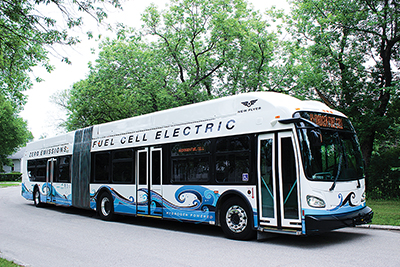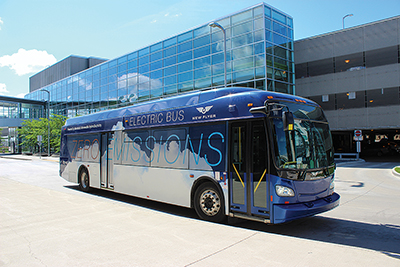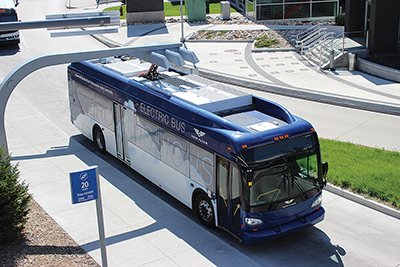
By Jennifer McNeill
![]() Heightened public concern surrounding climate change, air quality and the supply of fossil fuels has certainly accelerated the testing and adoption of zero emission buses (“ZEBs”) throughout North America over the last couple of years. A zero-emission transit bus is able to eliminate 1,690 tons of CO2, 10 tons of nitrogen oxides, 350 pounds of particulate matter (Source: U.S. Department of Transportation), and can save hundreds of thousands of dollars in fuel costs over its 12-year lifespan. Regardless of the technology a transit agency selects, every zero-emission bus eliminates the need for up to 160,000 gallons of fossil fuel. It’s simply good, sustainable innovation in our communities.
Heightened public concern surrounding climate change, air quality and the supply of fossil fuels has certainly accelerated the testing and adoption of zero emission buses (“ZEBs”) throughout North America over the last couple of years. A zero-emission transit bus is able to eliminate 1,690 tons of CO2, 10 tons of nitrogen oxides, 350 pounds of particulate matter (Source: U.S. Department of Transportation), and can save hundreds of thousands of dollars in fuel costs over its 12-year lifespan. Regardless of the technology a transit agency selects, every zero-emission bus eliminates the need for up to 160,000 gallons of fossil fuel. It’s simply good, sustainable innovation in our communities.
ZEB technology has been evolving for more than two decades in North America. While battery-electric buses are the most widely publicized, trolley-electric and hydrogen fuel cell-electric buses are also in active transit service in cities throughout the United States and Canada. All three ZEB technologies are electric buses driven by electric motors, with common power electronics and common electric accessories, such as power steering, doors and HVAC systems. Selecting a zero-emission bus technology basically boils down to making choices regarding the investment in onboard energy storage and “fueling” methods.
The pros and cons
Today’s ZEB technology choices by have become a trade-off between vehicle range and infrastructure complexity and cost.
Trolley-electric ZEBs are electric buses that use electricity from overhead wires to drive an electric motor. Despite the very minimal onboard energy storage, this technology has virtually unlimited range. The primary drawback to trolley-electric buses are the high infrastructure constraints and costs. Trolley-electric buses are limited to specific routes with installed overhead catenary systems, and allow for very short “off-wire” operation. Trolley-electric buses are a great choice for cities that have already invested in the infrastructure.

Hydrogen fuel cell-electric ZEBs are electric buses incorporating a small hydrogen fuel cell that operates as an on-board battery charger. The technology uses advanced hydrogen fuel cells and regenerative braking to charge batteries on board, resulting in vehicle range in excess of 250 miles. This allows agencies to adopt electric buses on virtually any transit route without relying on electricity from the utility grid. It does however, require the investment in hydrogen fueling islands at the transit depots (similar to compressed natural gas) and requires the supply or creation of hydrogen. Hydrogen fuel cell-electric buses are a great choice for agencies who wish to employ similar fueling methods to today’s practices and avoid the complex and costly infrastructure for re-charging batteries. While there is definitely a higher up front cost for fuel cells in today’s market, the evolution of fuel cell technology is expected to reduce the component cost and weight in the coming years.
Battery-electric ZEBs are electric buses that store energy in flexible, modular, onboard battery packs. The total capacity of onboard battery packs determines the vehicle range. Although regenerative braking is also involved, all battery-electric buses require investment in charging infrastructure to re-charge the batteries (Depot Plug-in Charging or On-Route Charging), and an electricity grid capable of charging large numbers of vehicles.

Investment in on-route charging infrastructure allows the battery-electric bus to have unlimited range with a lighter, more efficient vehicle but typically requires a more expensive and complicated infrastructure solution than plug-in charging, and constrains the buses to specific routes where on-route chargers are installed.
A depot charging strategy requires the investment in more onboard energy storage but simplifies route planning and has the added benefit of charging during off-peak hours, when electricity costs are lower. Unfortunately, even with the most advanced automotive battery technology available on the market today, maximum allowable axle weights constrain the number of battery packs that can be installed before compromising passenger capacity. As automotive battery technology evolves and becomes mainstream, it is expected that the component cost and weight will reduce, allowing for greater onboard energy storage capacity, passenger capacity and range.
Battery-electric ZEB technology adds the complexity of grid management and interoperability, meaning – the ability to provide enough electricity to charge a large number battery-electric buses from multiple manufacturers using a single charging technology. Although charging standards for battery-electric ZEBs do not exist today, it is critical that bus and charging equipment manufacturers collaborate to introduce and comply with standards for both on-route and depot plug-in charging to simplify the infrastructure requirements.

Other considerations
Electric bus technology works, and it is here to stay. While onboard energy storage and infrastructure technology is evolving quickly, the expected service life of a North American heavy-duty transit bus remains unchanged. The bus has to reliably meet pull out and safely carry passengers every day for at least 12 years or 500,000 miles. When choosing a ZEB technology, consider the reliability of the vehicle and its subsystems, as well as the ability of the manufacturer and the major component suppliers to support the vehicle for the life of the bus.
Jennifer McNeill serves as vice president of sales & business development for New Flyer. New Flyer is the only manufacturer in North America that offers three types of zero-emission electric buses – battery-electric, trolley-electric, and fuel cell-electric. Visit www.newflyer.com.
